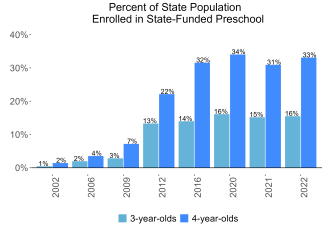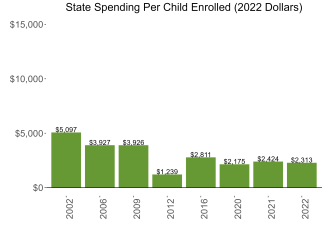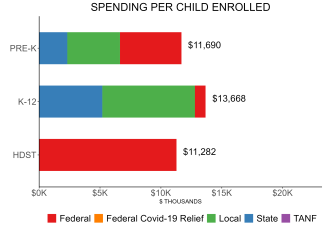
State of Preschool
Nebraska
Access Rankings
Resource Rankings
Total Benchmarks Met

Overview
During the 2021-2022 school year, Nebraska preschool enrolled 13,360 children, an increase of 554 from the prior year, as the program began to recover from the impact of the COVID-19 pandemic. State spending totaled $30,903,375, down $133,689 (0.4%), adjusted for inflation since last year. State spending per child equaled $2,313 in 2021-2022, down $111 from 2020-2021, adjusted for inflation. Nebraska met 7 of 10 quality standards benchmarks.
What's New

In May 2022, the Nebraska Department of Education authorized the use of ESSER funds to be utilized within up to six Educational Service Units to support PreK-2nd grade teachers with dedicated Professional Development Specialists for two years. The intent of these specialists is to provide educators with someone at a regional level with PreK-2nd grade dedicated support in the areas of appropriate teaching practice, curricular support, formative/observational assessment, Pyramid/PBIS implementation, and/or transitions, based on the needs of the specific regions.
Additionally, in December 2022, Nebraska was awarded a federal Preschool Development Grant Birth through Five (PDG B–5) one-year planning grant for $4 million.
Background
The Nebraska Early Childhood Education Program began as a pilot program in 1992 and expanded in 2001, providing preschool education for children ages three to five. Direct financial support is available on a competitive basis for public schools and education service units that partner with child care centers, Head Start agencies and/or human services agencies. Grantees are required to match 100% of the funding with local and/or federal sources.
At least 70% of the children in the program must have at least one of the following risk factors: disability or developmental delay, living in a home in which English is not the primary language, eligibility for free or reduced-price lunch (185% FPL), having teen parents or parents who have not completed high school, or having been born prematurely or with a low birth weight. The program seeks to serve children of diverse social and economic characteristics.
Most programs operate 3.5 to 4 hours per day, four or five days per week and must operate for a minimum of 12 hours per week during the school year. All teachers in the Nebraska Early Childhood Education Program are required to have at least a bachelor’s degree and training in early childhood education. The program monitors child, program, and family outcomes annually.
While the Early Childhood Education Grant Program has expanded, many districts and education service units fund their early childhood programs without the use of grants yet follow the same regulations as the grant program.
Nebraska Early Childhood Education Program
Access
Resources
| Total state pre-K spending | $30,903,375 |
| Local match required? | Yes |
| State Head Start spending | $0 |
| State spending per child enrolled | $2,313 |
| All reported spending per child enrolled* | $11,690 |

Pre-K programs may receive additional funds from federal or local sources that are not included in this figure. K–12 expenditures include capital spending as well as current operating expenditures. Head Start per-child spending includes funding only for 3- and 4-year-olds.
Nebraska Quality Standards Checklist
| Policy | Requirement | Benchmark | Meets Benchmark? |
|---|---|---|---|
For more information about the benchmarks, see the Executive Summary and the Roadmap to State pages. | 7benchmarks met | ||
| Early Learning & Development Standards Benchmark | Comprehensive, aligned, supported, culturally sensitive | Comprehensive, aligned, supported, culturally sensitive | |
| Curriculum Supports Benchmark | Approval process & supports | Approval process & supports | |
| Teacher Degree Benchmark | BA | BA | |
| Teacher Specialized Training Benchmark | ECE, ECE SpEd | Specializing in pre-K | |
| Assistant Teacher Degree Benchmark | K-6 Endorsement, 6 credits in CD or ECE, or previous experience | CDA or equivalent | |
| Staff Professional Development Benchmark | 15 hours/year; PD plans; Coaching for teachers participating in the Pyramid model | For teachers & assistants: At least 15 hours/year; individual PD plans; coaching | |
| Maximum Class Size Benchmark | 20 (3- & 4-year-olds) | 20 or lower | |
| Staff to Child Ratio Benchmark | 1:10 (3- & 4-year-olds) | 1:10 or better | |
| Screening & Referral Benchmark | Determined locally | Vision, hearing & health screenings; & referral | |
| Continuous Quality Improvement System Benchmark | Structured classroom observations; Data used for program improvement | Structured classroom observations; data used for program improvement | |

